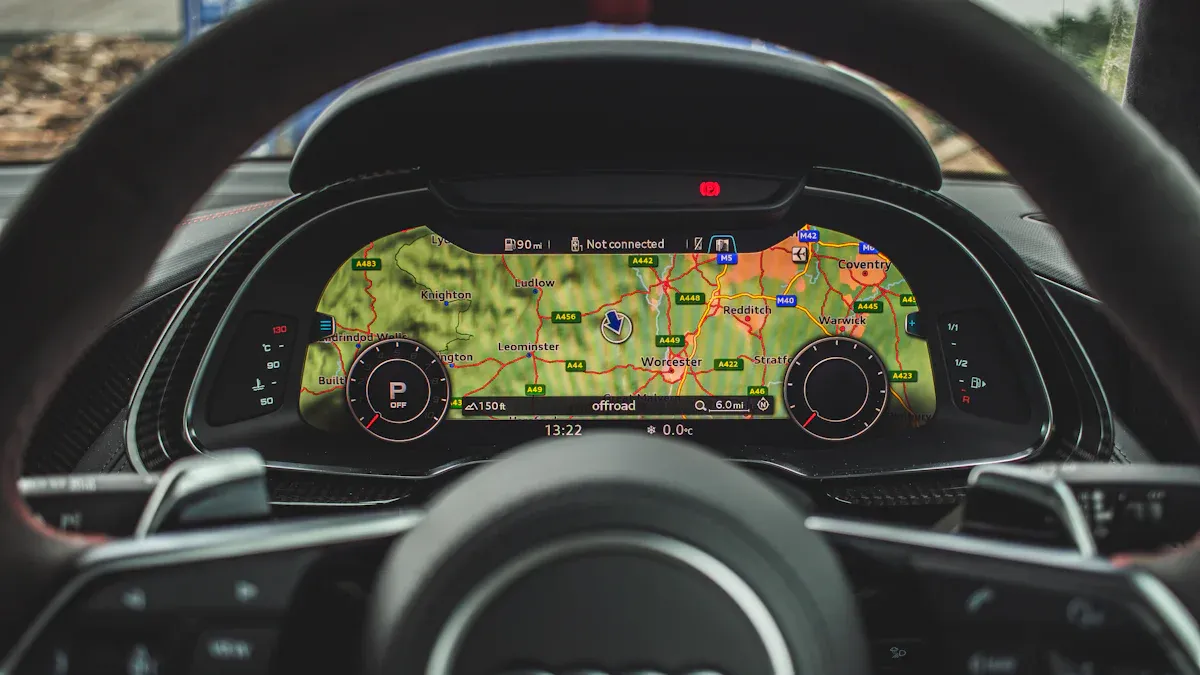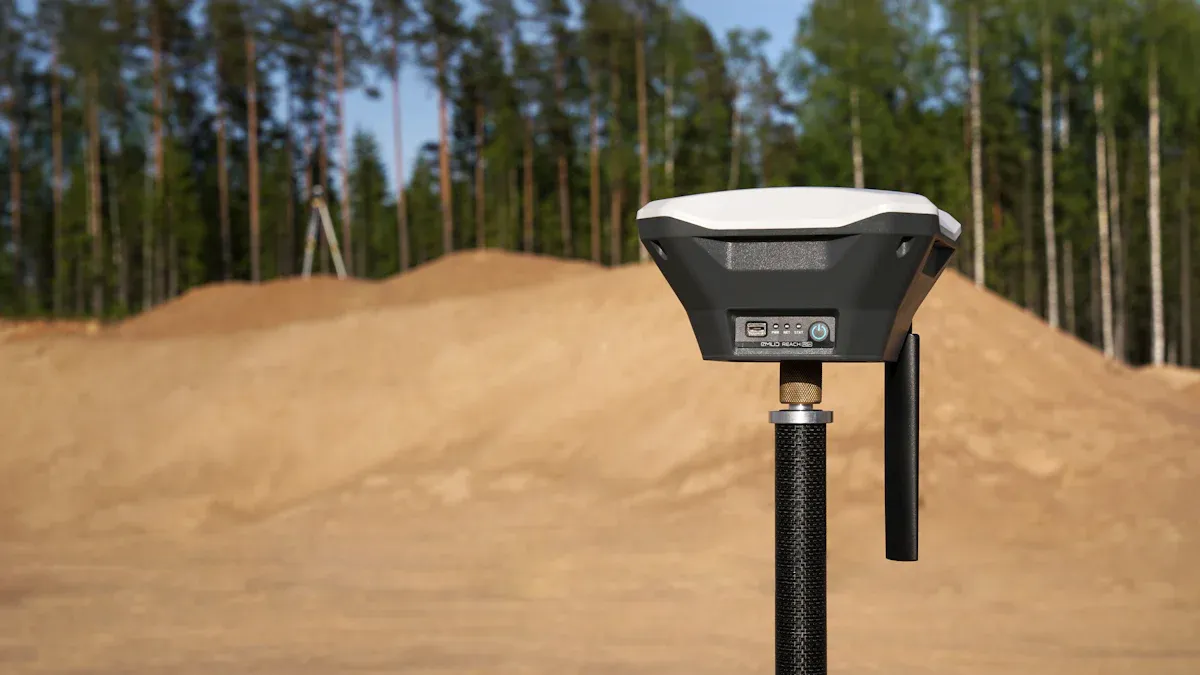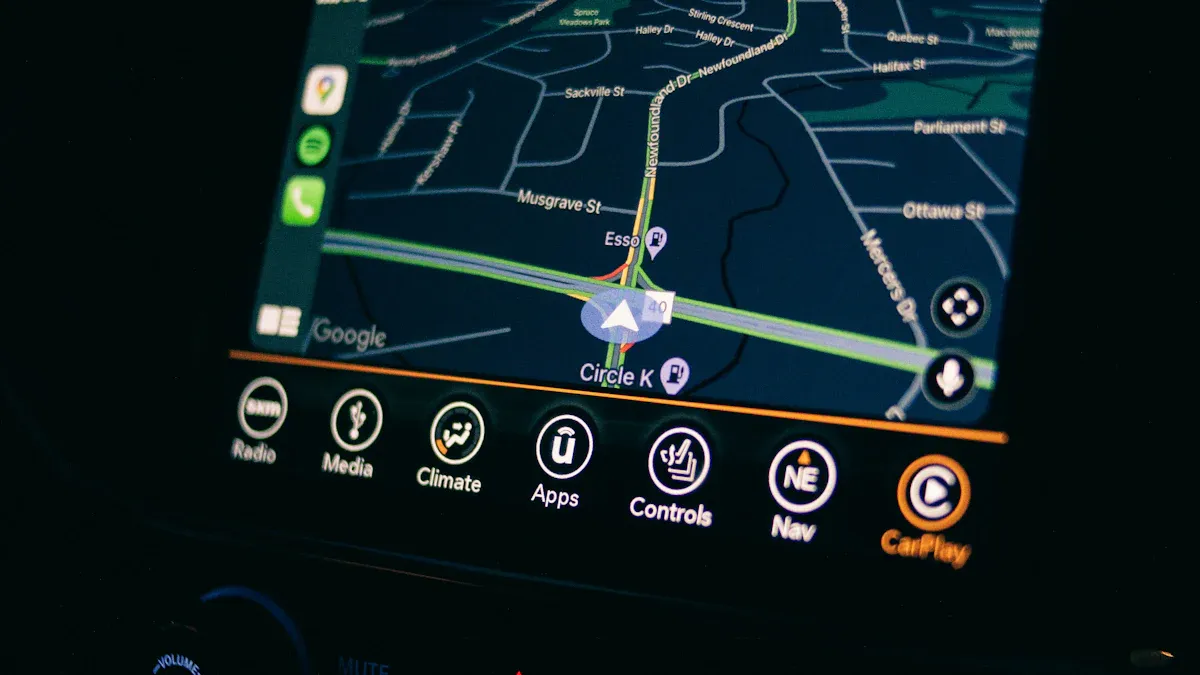
GNSS-Triggered Digital Signage for Vehicles helps show the right message in the right spot. Imagine you are on a city bus. When the bus goes into a new area, the screen quickly shows ads or travel tips for that place. You do not have to change the screens by hand. This system uses live location data. It is easy for you to control the information. Passengers get updates that matter to them.
You might ask how this system knows when to change messages. The secret is that it uses smart location signals.
Key Takeaways
GNSS-triggered digital signage uses satellite signals to show messages based on where a vehicle is. The system changes screens by itself as the vehicle moves. This saves time and gives passengers helpful and timely information. Using GNSS with sensors like IMUs keeps tracking correct, even in tunnels or busy cities. This technology makes the ride better by showing live updates, safety tips, and local ads for each place. It helps workers do their jobs better by cutting down on manual updates. It also makes sure messages always match the current location.
What Is GNSS-Triggered Digital Signage for Vehicles

Definition
You may wonder what GNSS-Triggered Digital Signage for Vehicles is. This system uses signals from satellites to find out where your vehicle is. GNSS means Global Navigation Satellite System. It uses GPS and other satellite networks. With this technology, your vehicle can show digital messages for your exact spot. For example, a bus can show a welcome message when it gets to a new city. You do not have to change the screen by yourself. The system does this job for you.
Tip: GNSS-Triggered Digital Signage for Vehicles works right away. You always see the newest information.
Core Function
The main job of this system is to link your vehicle’s location with the right digital content. Here is how it works:
The GNSS receiver in your vehicle gets location data from satellites.
The system checks this data with a map of zones or routes.
When your vehicle goes into a new area, the system changes the display to show the right message.
You can use this for many things. You might show ads for local stores, safety alerts, or tips for tourists. The system helps you give passengers information that matters to them. You also save time because you do not have to change the content yourself.
Feature | What It Does |
|---|---|
Real-time updates | Shows new content as you move |
Location-based content | Matches messages to your position |
Automatic switching | Changes screens without manual input |
GNSS-Triggered Digital Signage for Vehicles makes your job easier. You give the right message at the right time, every time.
How It Works

Data Collection
You need good data for GNSS-Triggered Digital Signage for Vehicles to work. Your vehicle gets information from many places:
Inertial measurement units (IMUs) watch how your vehicle moves and turns.
Sensors like lidar and cameras take pictures and scan the road.
The system saves the time for each picture and sensor reading.
It gathers pose data, which shows where your vehicle is and which way it faces.
The system adds details like lane lines, road markings, and traffic signs.
Calibration data helps all sensors work together better.
The system removes moving things and noise to focus on the road.
Your vehicle also checks its speed and what it plans to do next. This helps keep driving safe and tells the system when to change messages. The data helps your vehicle talk to other cars and road systems by sharing its spot and speed.
Tip: Using GNSS with IMU and other sensors helps your vehicle know its location, even in tunnels or places with weak satellite signals.
Content Mapping
You must match your vehicle’s spot with the right digital content. The system uses strong GNSS receivers that work with many satellites and signals. This setup makes mistakes from the air smaller and gives you better location info. Cheap GNSS receivers, when used with IMUs and correction tools like Differential GNSS (DGNSS) or Real-Time Kinematic (RTK), can be very accurate. Some systems can even be right within a few centimeters if everything is perfect.
The system splits your route into zones or special places. Each zone links to certain content, like ads, safety tips, or tourist info. The mapping uses:
Technical Aspect | Details and Role in Integration |
|---|---|
Use signals from many satellites and bands to lower mistakes and make things more reliable. | |
RTK Algorithms | Use special tracking and correction data for very high accuracy. |
Broadcast GNSS Correction Services | Give error fixes from base stations or satellites to make things more accurate and faster. |
Inertial Sensors and Sensor Fusion | Keep tracking your spot when GNSS signals are weak or gone, like in tunnels. |
In-vehicle Sensors (Wheel-tick) | Help check and make dead reckoning more accurate. |
Dynamic Vehicle Model | Make sure the position data matches how vehicles move. |
The system uses these tools to make a map that matches your path with the right messages. You get the best and fastest updates possible.
Content Switching
When your vehicle goes into a new zone, the system checks your spot right away. GNSS-Triggered Digital Signage for Vehicles uses the newest GNSS data, sensor fusion, and correction tools to know where you are. The system then changes the display to show new content based on your spot.
You do not have to do anything. The system works by itself. For example, when your bus gets close to a shopping area, the screen can show ads for stores. When you reach a tourist place, the screen can show travel tips or safety notes. The system uses backup sensors and AI to keep working, even if the GNSS signal is lost for a bit.
Note: The system can change content very accurately, even in busy cities where satellite signals bounce off buildings. This makes sure passengers always see the right message at the right time.
GNSS-Triggered Digital Signage for Vehicles lets you share location-based content in a strong way. You get real-time updates that match your exact spot on the road.
Key Benefits
Passenger Experience
When you use GNSS-Triggered Digital Signage for Vehicles, your trips feel different. The system has special screens, like Full-window Augmented Reality, that show you live updates about where you are. You can spot landmarks, see building names, and notice tourist spots as you ride. This helps you remember places and learn about your trip. The big AR screen puts virtual things on top of real places, so it is easy to match what you see inside and outside. High-accuracy GNSS, like RTK, keeps the screen clear and smooth. You do not have to worry about slow or confusing displays. You get simple, easy-to-read updates that fit your spot. Many riders say they feel less lost and happier because the system gives them the right info at the right time. You also get a more fun and comfy ride than with old seat-back screens.
See live info about where you are
Learn about landmarks and tourist places
Enjoy smooth and clear AR screens
Feel more relaxed and know more on your trip
Targeted Messaging
You can send messages that match each place. The system checks where your vehicle is and shows ads, alerts, or tips that matter there. For example, you might see a restaurant ad in a shopping area or get safety tips near a busy road. This way, you do not waste time with messages that do not fit the place. You reach the right people with the right info. The system checks the spot before showing each message, so you know the info is right and on time.
Tip: You can use targeted messages for ads, tourism, or safety. This helps your messages work better.
Operational Efficiency
You save time and work with GNSS-Triggered Digital Signage for Vehicles. The system changes the screen by itself, so you do not have to do it. You get real-time updates that fit your route. The system checks the signals to make sure your spot is right. If the GNSS signal is weak, backup sensors keep things working. This means you can trust the screens to work all the time. You also make fewer mistakes and your work goes smoother. Fast updates help you react quickly to changes on the road.
Automatic screen changes
Reliable screens with backup help
Fewer mistakes and less work for you
Quick updates when your route changes
Implementation Steps
Hardware and Software
You need the right hardware to set up GNSS-Triggered Digital Signage for Vehicles. Start with a GNSS receiver. This device gives your system the exact location of your vehicle. Add an Inertial Measurement Unit (IMU) to measure how your vehicle moves. DSRC radios help your vehicle talk to other vehicles and road systems. You also need a Human-Machine Interface (HMI). This screen shows messages to drivers or passengers. Each part works together to make sure your system knows where you are and what to show.
For software, choose a digital signage platform that can read GNSS data. The software should let you map zones and link them to content. Some programs offer easy drag-and-drop tools. You can update messages from a central office or even from your phone.
Tip: Pick hardware and software that can handle updates and new features. This helps your system last longer.
Integration
You must connect your hardware and software to your vehicle’s systems. Plug the GNSS receiver and IMU into the main computer. Make sure the HMI screen fits where passengers can see it. Link the digital signage software to your vehicle’s data network. Test each part to check that messages change when your vehicle enters a new area.
Use a checklist to track each step:
Connect GNSS receiver and IMU
Install HMI display
Set up DSRC radios
Load digital signage software
Test content switching
A good setup lets you control messages from one place. You can also add new zones or change content as your routes grow.
Maintenance
Keep your system working by checking it often. Clean the HMI screens and check cables for damage. Update your software to fix bugs and add new features. Test the GNSS receiver and IMU to make sure they give the right data. If you see errors, restart the system or call for help.
Note: Regular checks help you avoid problems and keep your GNSS-Triggered Digital Signage for Vehicles running smoothly.
Use Cases
Public Transit
You can find GNSS-Triggered Digital Signage for Vehicles on city buses and trains. This system helps you get the right info at the right time. When your bus gets near a stop, the LED sign shows the next stop. The system also plays sounds inside and outside the bus. You always know where you are and what stop is next.
The signs change by themselves as the bus moves.
Audio messages tell you about stops and route details.
Real-time tracking lets the system change messages if the bus is early or late.
Passenger counting sensors work with the signs to show how many people get on or off.
The controller can talk to traffic lights and ask for green lights if the bus is late.
Note: All these tools work together in one smart controller. You get a smooth ride, clear updates, and better on-time service.
Commercial Fleets
You can use GNSS-Triggered Digital Signage for Vehicles in delivery trucks, service vans, or company shuttles. The system helps you share the right message with drivers, workers, or customers. For example, a delivery truck can show safety alerts when it enters a busy area. A company shuttle can show welcome messages when it gets to a business park.
Show safety tips or alerts based on where you are.
Update delivery or service info right away.
Help drivers follow the best route with live updates.
Share company news or deals with passengers.
This system makes your fleet smarter and your messages more helpful. You save time, make things safer, and keep everyone up to date.
You can make your fleet better with GNSS-Triggered Digital Signage for Vehicles. This system gives updates based on where you are and what is happening right now. Both drivers and passengers get helpful information. You can use open-source projects like the Altium GNSS + LTE Asset Tracker. You can also get help from u-blox experts to start your setup.
In the future, things like AI, 5G, and improved GNSS receivers will help your signage work even better and be more dependable.
Check out these tools to help your vehicles have safer, smarter, and more interesting trips.
FAQ
How does GNSS-triggered digital signage know when to change content?
Your system uses satellite signals to track your vehicle’s location. When you enter a new area or zone, the system matches your spot with the right message and updates the screen automatically.
Can GNSS-triggered signage work in tunnels or cities with tall buildings?
Yes! Your system uses backup sensors like IMUs and wheel sensors. These help keep tracking your location when satellite signals get weak or blocked.
What types of content can you show with this system?
You can display many things, such as ads, safety alerts, tourist tips, or route updates. The system lets you match each message to a specific place or event.
Do you need special training to use or update the system?
No, you do not need special training. The software uses simple tools. You can update messages from your phone or computer. Most systems offer easy guides and support.
See Also
Budget-Friendly Portable CarPlay Solutions Suitable For All Drivers
Top Five Wireless CarPlay Adapters To Simplify Driving
Best CarPlay HDMI Dongles Delivering 4K Streaming In 2025
